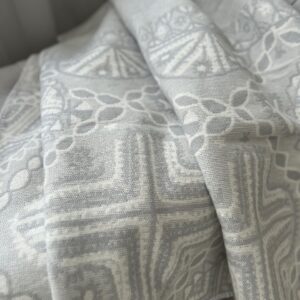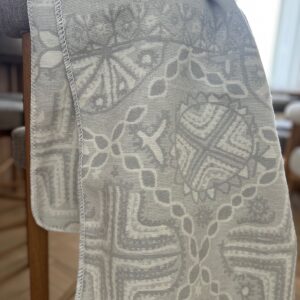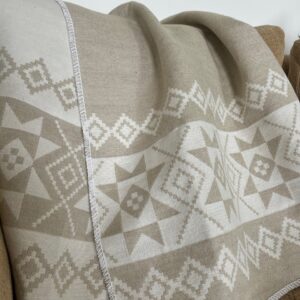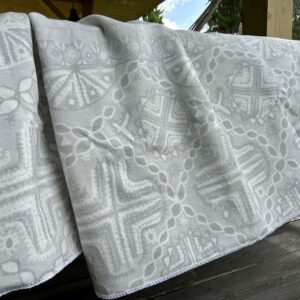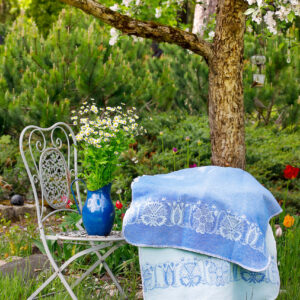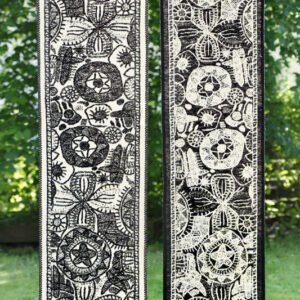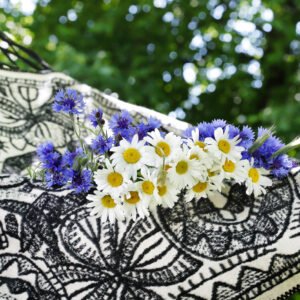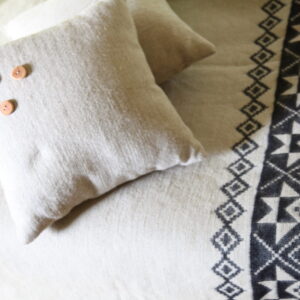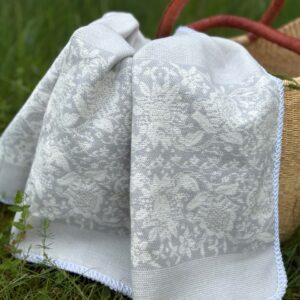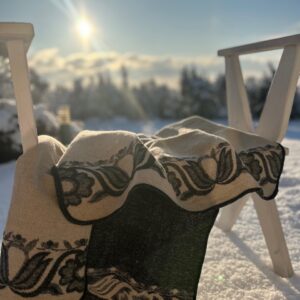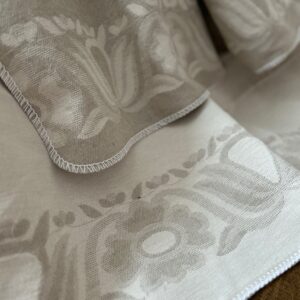-
Mõõdud 110 x 180 cm 100% puuvill. Lõuna-Eesti sõba Tartumaal ei olnud tikandid kuigi rikkalikud, pigem olid need tagasihoidlikud. Esile tulevad erinevate värviliste lõngade kasutamine n. valge, pruun, punane, roheline, sinine. Põhiliselt kasutati sõbade kaunistamiseks sissekootud värvilisi triipe ja pistete kombinatsioone. Lõuna-Eesti sall on inspireeritud Tartu rahvariiete särgi kirjast. Tartu sõba kaunistab kaheksaharuline täht, mille motiivi ääristab ruutudest koosnev siksakjoon.
-
Mõõdud 70x200 cm70% puuvill, 30% linaTartumaal ei olnud tikandid kuigi rikkalikud, pigem olid need tagasihoidlikud. Esile tulevad erinevate värviliste lõngade kasutamine n. valge, pruun, punane, roheline, sinine. Põhiliselt kasutati sõbade kaunistamiseks sissekootud värvilisi triipe ja pistete kombinatsioone. Lõuna-Eesti sall on inspireeritud Tartu rahvariiete särgi kirjast. Tartu sõba kaunistab kaheksaharuline täht, mille motiivi ääristab ruutudest koosnev siksakjoon.
-
Mõõdud 70x200 cm70% puuvill, 30% linaTartumaal ei olnud tikandid kuigi rikkalikud, pigem olid need tagasihoidlikud. Esile tulevad erinevate värviliste lõngade kasutamine n. valge, pruun, punane, roheline, sinine. Põhiliselt kasutati sõbade kaunistamiseks sissekootud värvilisi triipe ja pistete kombinatsioone. Lõuna-Eesti sall on inspireeritud Tartu rahvariiete särgi kirjast. Tartu sõba kaunistab kaheksaharuline täht, mille motiivi ääristab ruutudest koosnev siksakjoon.
-
Mõõdud 70x200 cm70% puuvill, 30% linaTartumaal ei olnud tikandid kuigi rikkalikud, pigem olid need tagasihoidlikud. Esile tulevad erinevate värviliste lõngade kasutamine n. valge, pruun, punane, roheline, sinine. Põhiliselt kasutati sõbade kaunistamiseks sissekootud värvilisi triipe ja pistete kombinatsioone. Lõuna-Eesti sall on inspireeritud Tartu rahvariiete särgi kirjast. Tartu sõba kaunistab kaheksaharuline täht, mille motiivi ääristab ruutudest koosnev siksakjoon.
-
Mõõdud 110 x 180 cm 100% puuvill
-
Mõõdud 70 x 200 cm 100% puuvill
Põltsamaa tanutikandi mustriga kaunistatud Ellu sallide sõba sündis III Eesti Naiste Tantsupeo auks, mis toob taas rahva kokku Jõgevamaale. Tantsupeo auks, mis liidab pered, põlvkonnad ja südamed igas Eesti paigas.
Peo pealavastaja Ave Anslan harutab III naiste tantsupeo loo lahti läbi pere rõõmude. Suureks rahvapeoks saanud sündmusel tantsitakse taas meie rahva südametesse ja juurtesse lapse mängurõõm, vanaema asjatamised ning pereema argipäev. Tantsupeo „PereLugu“ esitavad kolme põlvkonna naised, tantsides koos perega olemise ajast, mis on oluline aeg elust.
Ka minu jaoks on perekond kõige tähtsam ning koon need tunded sõbasse mille mustrid on pärit tanu tikandilt Pajusi külast Põltsamaa vallast, Jõgevamaalt. See Eesti Rahva Muuseumi (ERM) kogust leitud väike lilltanu oli 1850. aasta paiku valmistatud meie esiemade poolt linasest kangast ning kaunistatud viie lillega. Iga õis on tikitud erinevate siniste toonidega. Sinine on ka III Eesti Naiste Tantsupeo üheks tunnusvärviks.
Naiste tantsupeo auks valmistatud sõba muster jutustab ka traditsioonist, mille kohaselt oli tanu tunnus naisest, kes abielus ja kelle peres lapsigi. Põltsamaa abielunaised kandsid pika sopiga püsttanu ja nimetasid seda linukaks ehk sabaga tanuks või kaunilt linutamisehteks. Linuk jäi hinnalise esemena kättesaadavaks peamiselt jõukamale rahvale. Küll ehtis sabaga tanu siiski igat pruuti tema esimesel pulmapäeval. Teisel päeval kanti juba väikest tanu, uhke linutamisehe oli edaspidi vaid kirikus käimiseks ja pidulikeks päevadeks. Linasest peakatet kaunistasid tavaliselt saksa käsitöömeistrite poolt tikitud lilltikandid.
Vanades pulmakommetes mängisid nii sõba kui tanu olulist rolli ning olid abielunaise piduülikonna osana rikkalikult kaunistatud. Mõlemad jäid ka 19. sajandi alguses kasutusele just pruudirõivana. Põltsamaa kihelkonnas oli omane kanda linaseid nurktoimsest ehk kilpsilmsest jämedast linasest riidest kahelaidseid sõbasid, mida hüüti palakateks. Kui peigmees pruudi koju tõi, siis sidus ämm noorikule sõba silmade ümber, riputas talle teri pea pealaele, nimetas teda tibuks ja kanaks. Nõnda olles pidi pruut oma perenaise oskusi tõestama, pannes ahju puuhalgusi või pühkides tuba.
Nõnda seovad ka Ellu sallide loodud sõbad ning nende mustrite saamislood pered, põlvkonnad ja südamed.
-
-
-
Dimensions 145 x 200 cm 70% cotton, 30% flax In South Estonia the embroidery was rather modest. Using yarns of different colours, white, brown, red, green, blue i.e. became more common. Colourful stripes woven in the fabric and combinations of stitches were the main ways to decorate the shawls. South Estonian shawl has been inspired by the pattern of the Tartu folk costume shirt. Tartu shawl has been decorated with an eight-branch star that is surrounded with zigzag line consisting of squares.
-
70x200, 100% cotton
-
105 x1 80
-
140 x 200
+ Näita rohkem



